Complete Solutions to Chemical Kinetics of chapter CHEMICAL KINETICS of Class 12 book with complete answers and questions
| Class 12 | CHEMISTRY |
| Chapter | CHEMICAL KINETICS |
| NCERT EXEMPLAR | Chemical Kinetics |
| Number Of Questions | 66 |
| Academic Year | 2023-24 |
The role of a catalyst is to change……….
00:43View SolutionIn the presence of a catalyst, the heat evolved or absorbed during the reaction ………. .
View SolutionActivation energy of a chemial reaction can be determined by …….. .
04:10View SolutionConsider figure and mark the correct option
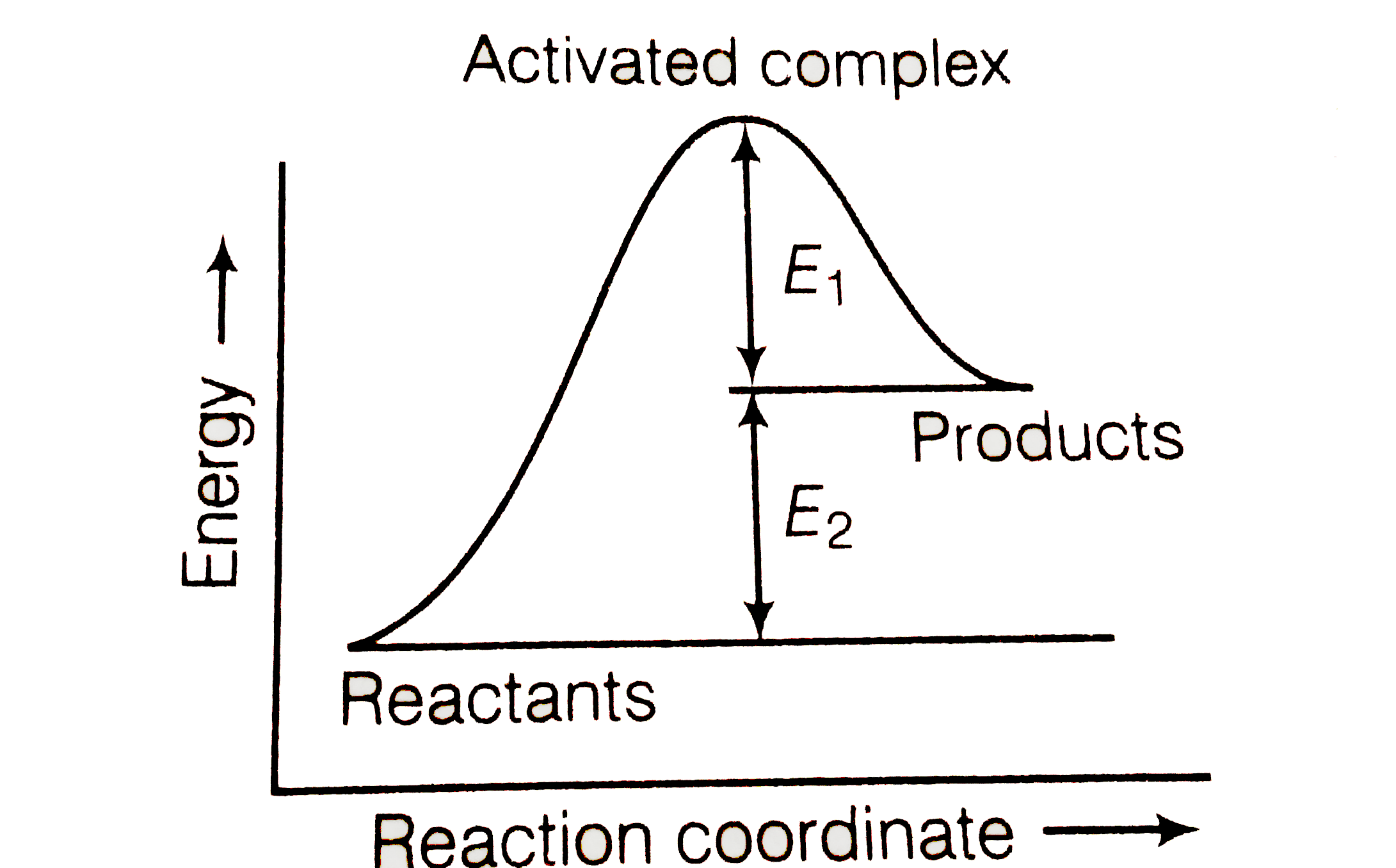 01:39View Solution
01:39View SolutionConsider a first order gas phase decompostion reaction gives below
`A(g) to B(g) to C(g)`
The initial pressure of the system before decomposition of A `p_(i)`. After lapse of time 't' total pressure of the system increased by x units and became `p_(t)`. The rate constant K for the reaction is given as....... .03:11View SolutionAccording to Arrhenius equation rate constant K is equal to A `e.^(-E_(a)//RT)` . Which of the following options represents the graph of ln K vs `(1)/(T)`?
03:28View SolutionConsider the Arrhenius equation given below and mark the correct option.
`k=A e^(-(Ea)/(RT)`02:29View SolutionA graph of volume of hydrogen released vs time for the reaction between zinc and dil. HCl is given in figure . On the basis of this markt the correct options.
 03:03View Solution
03:03View SolutionWhich of the following statement is not correct about order of a reaction ?
02:26View SolutionConsider the graph given in figure . Which of the following options does not show instantaneous rate of reaction at 40 ?
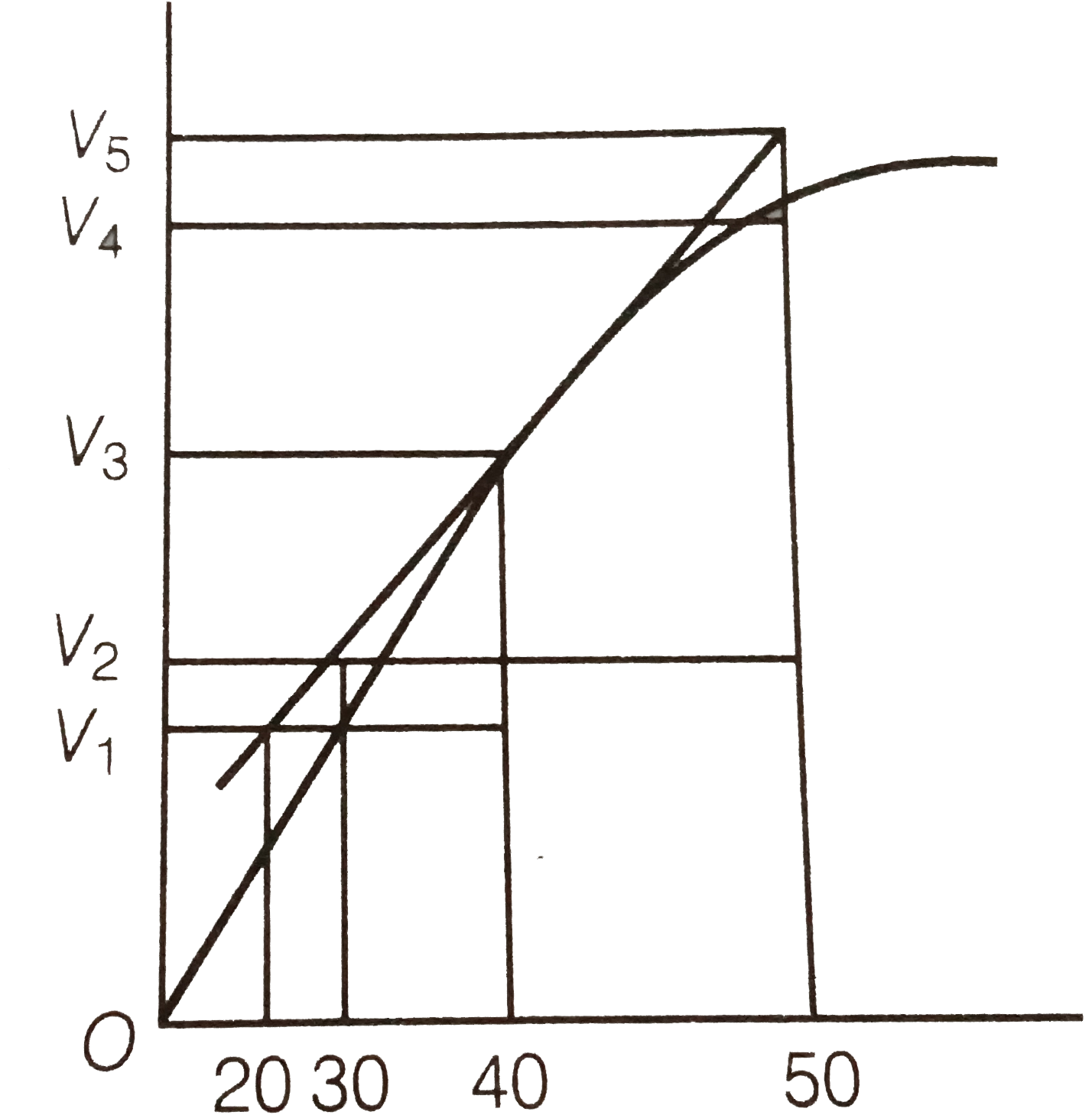 04:52View Solution
04:52View SolutionWhich of the following statements is correct ?
02:41View SolutionWhich of the following expression is correct for the rate of reaction given below ?
`5Br^(-)(aq) + BrO_(3)^(-)(aq) + 6H^(+) (aq) to 3Br_(2) (aq) + 3H_(2) O(l)` .04:17View SolutionWhich of the following graph represents exothermic reaction ?
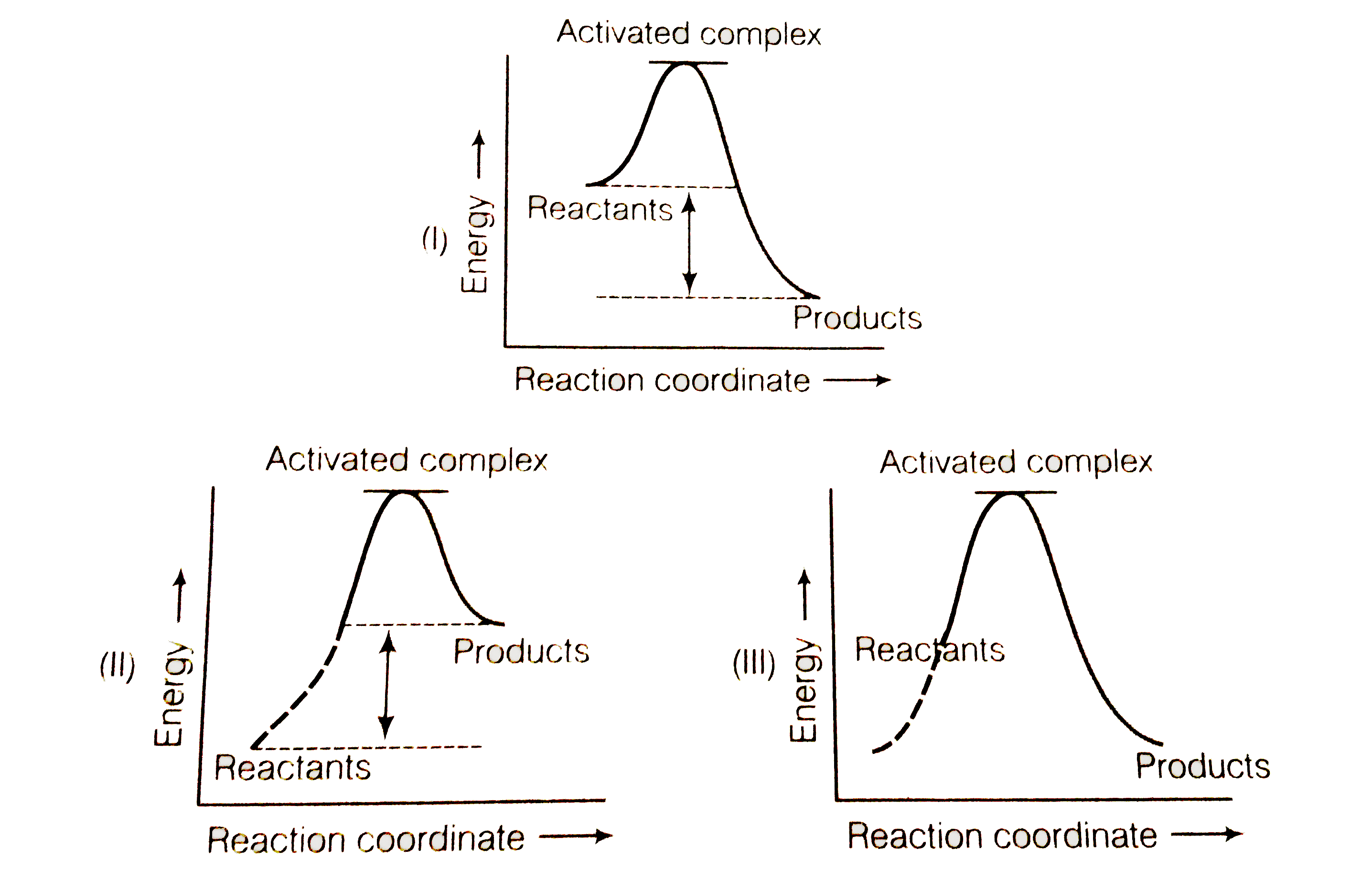 04:18View Solution
04:18View SolutionRate law for the reaction, `A + 2B to C` is found to be
Rate `= k [A] [B]`
Concentration of reactant 'B' is doubled keeping the concentration of 'A' constant, the value of rate constant will be _______02:32View SolutionWhich of the following statements is incorrect about the collision theory of chemicacl reaction ?
03:05View SolutionA first order reaction is `50%` completed in `1.26 xx 10^(14)`s. How much time would it take for `100%` completion?
01:37View SolutionCompounds 'A' and 'B' react according to the following chemical equation.
`A(g) to 2B(g) to 2C(g)`
Concentration of either 'A' or 'B' were changed Keeping the concentration of one of the reactants constant and rates were measured as a function of initial concentration. Following result were obtained.
Choose the correct option for the rate equations for this reaction.
 06:30View Solution
06:30View SolutionWhich of the following statement is not correct for the catalyst ?
03:27View SolutionThe value of rate constant of a pseudo first order reaction
01:11View SolutionConsider the reaction `A to B`. The concentration of both the reactants and the products varies exponentially with time. Which of the following figure correctly describes the change in concentration of reactants and products with time ?
02:01View SolutionRate law cannot be determined form balanced chemical equation if …….. .
03:03View SolutionWhich of the following statements are applicable to a balanced chemical equation of an elementary reaction ?
02:19View SolutionIn any unimoelcular reaction ……. .
03:33View SolutionFor a complex reaction ……… .
03:57View SolutionAt high pressure the following reaction is zero order.
`" "2NH_(3)(g) underset("Platinum catalyst")overset(1130 K)to N_(2)(g) + 3H_(2)(g)`
Which of the following options are correct for this reaction ?04:26View SolutionDuring decomposition of an activated complex
03:59View SolutionAccording to Maxwell , Boltzmann distriubtion of energy ……… .
04:04View SolutionIn the graph showing Maxwell, Boltzmann distribution of energy ……….. .
03:21View SolutionWhich of the following statements are in accordance with the Arrheenius equation ?
03:39View SolutionMark the incorrent statements.
View SolutionWhich of the following graph is correct for a zero order reaction ?
View SolutionWhich of the following graph is correct for a first order reaction ?
04:38View SolutionState a condition under which a bimolecular reaction is kinetically first order reaction.
03:50View SolutionWrite the rate equation for the reaction `2A + B to C` if the order of the reaction is zero .
01:16View SolutionHow can you determine the law of the following reaction?
`2NO(g) + O_(2) (g) to 2NO_(2) (g)`02:57View SolutionFor which type of the reactions, order and molecularity have the same value ?
01:25View SolutionIn a reaction if the concentraion of reaction A is tripled, the rate of reaction becomes twety seven times. What is the order the reaction ?
02:57View SolutionDerive an expression to caluclate time required time required for completion of zero order reaction.
03:30View SolutionFor a reaction `A+ B to ` Products, the rate law is -Rate `= k[A][B]^(3//2)`
Can the reaction be an elementray reaction ? Explain.02:09View SolutionFor a certain reacation large fraction of molecules has energy more than energy more than the threshold enrgy,yet the rate of reaction is very slow. Why ?
View SolutionFor a zero order reaction will the molecularity be equal to zero ? Explain.
02:11View SolutionFor a general reaction `A to B`, plot of concentration of A vs time is given in figure. Answer the following questions on the basis of this graph.
(i) what is the order of the reaction?
(ii) What is the slope of the curve ?
(iii) What are the units of rate constant?
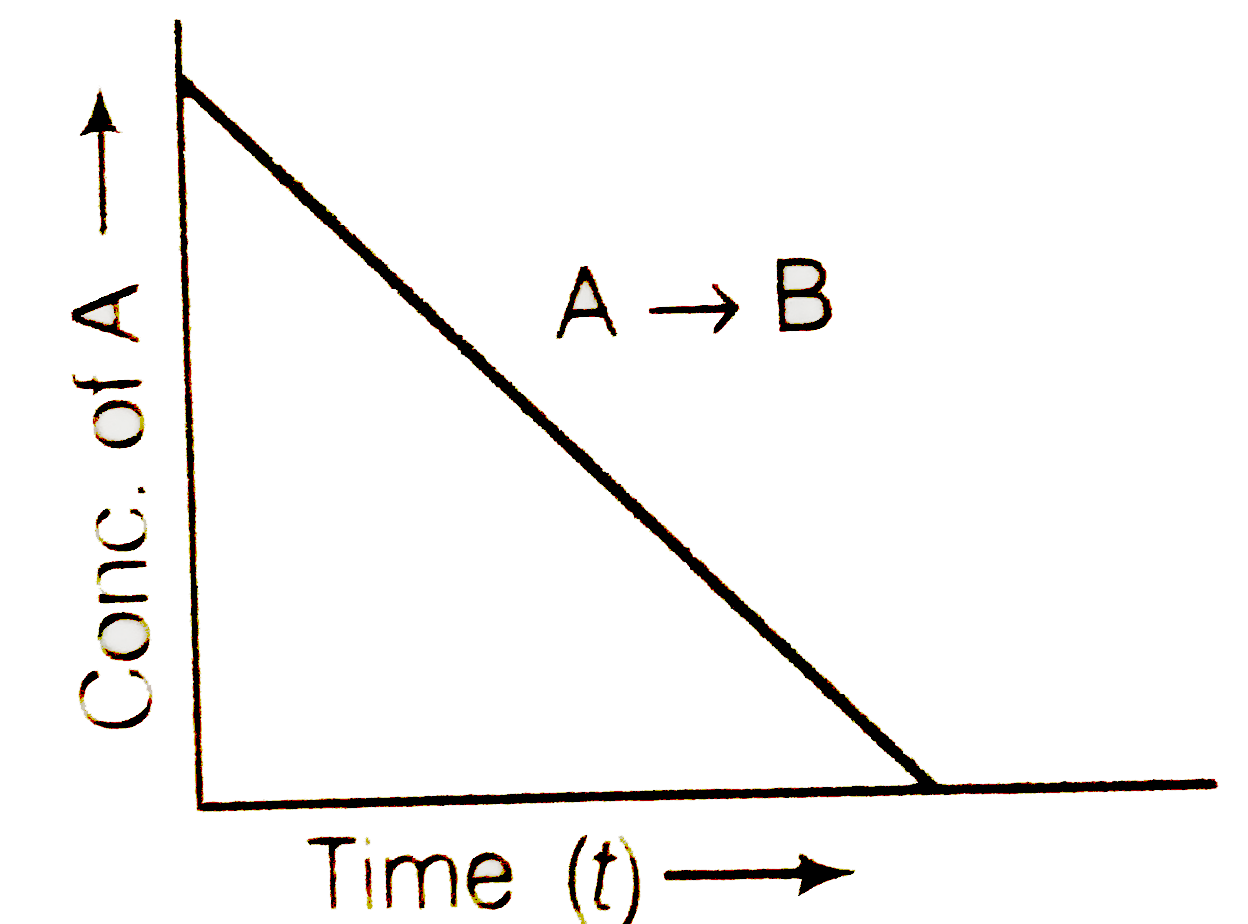 05:30View Solution
05:30View SolutionThe reactions between `H_(2)(g) and O_(2)(g)` is highly feasuble yet allowing the gases to stand at room tempertaure in the same vessel does not lead to the formation of water . Explain
02:46View Solution Why does the rate of a reaction increase with rise in temperature?
02:32View Solution 0xygen is available in plenty in air yet fuels do not burn by themselves at room temperature. Explain.
02:18View SolutionWhat is the probability of reaction with molecularity higher than three very rare?
02:57View SolutionWhy does the rate of any reaction generally decreases during the course of the reaction?
01:16View SolutionThermodynamic feasibility of the reaction alone cannot decide the rate of the reaction. Explain with the help of one example.
02:56View SolutionWhy in the redox titration of `kMnO_(4)` vs oxalic acid, we heat oxalic acid solution before starting the titration?
01:48View SolutionWhy can't molecularity of any reaction be equal to zero?
00:59View SolutionWhy molecularity is applicable only for elementary reactions and order is applicable for elementary as well as complex reactions?
02:22View SolutionWhy can we not determine the order of a rection by taking into consideration the balanced chemical equation ?
02:36View SolutionMatch the grap given in column I with the order of reacting given in column II . More than one item in column I may link to the same item of Column.
 11:10View Solution
11:10View SolutionMatch the statements given in Column I abd Column II.
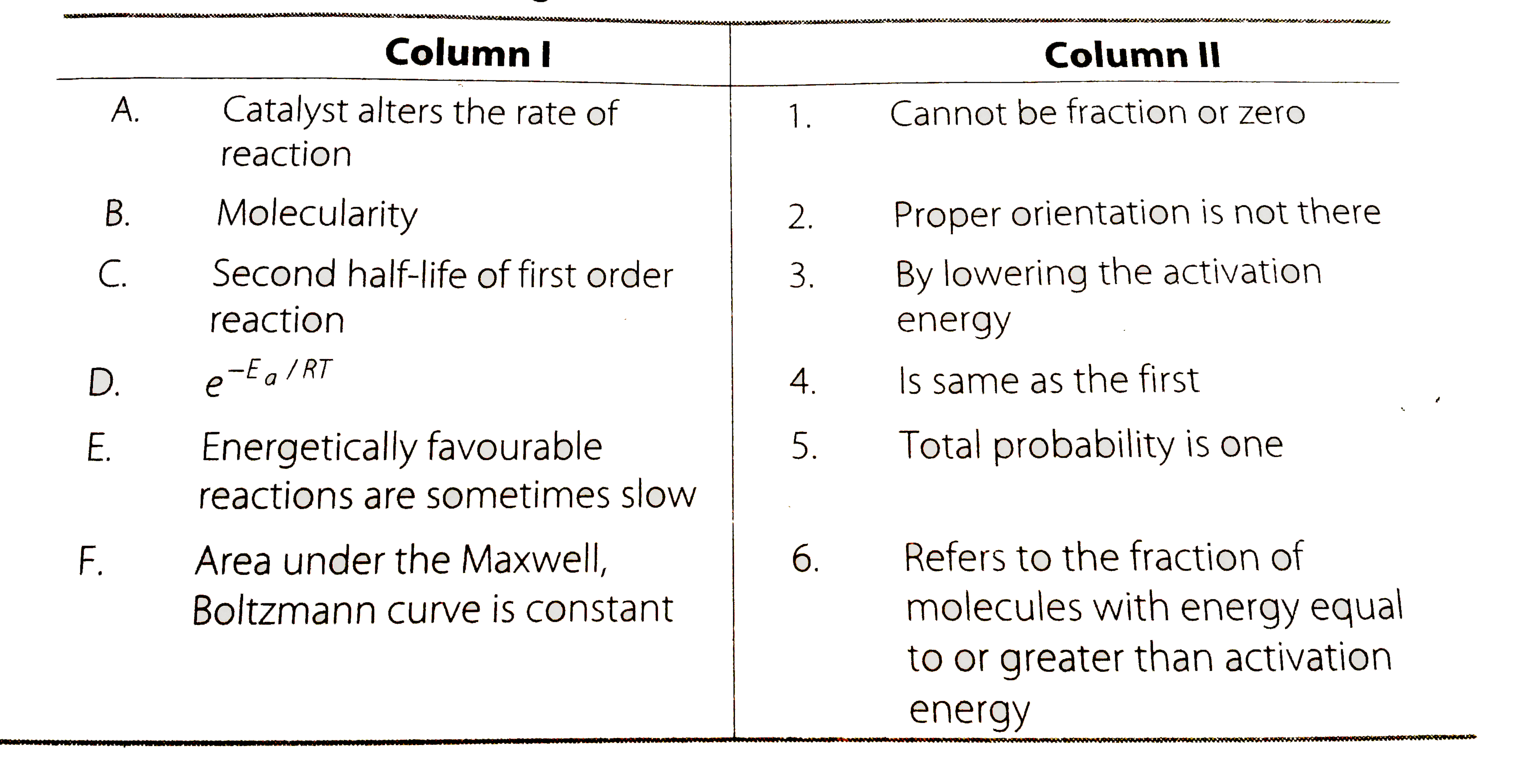 06:49View Solution
06:49View SolutionMatch the items of Column I and Column II.
 00:57View Solution
00:57View SolutionMatch the items of Column I and Column II.
 01:20View Solution
01:20View SolutionAssertion (A) Order of the reaction can be zero or fractional.
Reason (R) We cannot determine order from balanced chemical equation.01:37View SolutionAssertion (A) Order and molecularity are same.
Reason (R) Order is determined experimentally and molecularity is the sum of the stoichiometric coefficient of rate determining elementary step.01:26View SolutionAssertion (A) The enthalpy of reaction remains constant in the presence of a catalyst.
Reason (R) A catalyst participating in the reaction froms different activated complex and lowers down the activation energy but the difference in energy of reactant and product remains the same.01:19View SolutionAssertion (A) All collision of reactant molecules lead to product formation.
Reason (R) Only those collisions in which molecules have correct orientation and sufficent kinetic energy kinetic energy lead to compound formation.01:06View SolutionAssertion (A) Rate constant determined form Arrhenius equations are fairly accurate for simple as well as complex molecules.
Reason (R) Reatant molecules undergo chemical irrespective of their orientation during collison.01:31View SolutionAll energetically effective collisions do not result in a chemical change.
Explain with the help of an example.View SolutionWhat happes to most probable to the absolute temperatur and the energy of activation with increase in temperature ?
View SolutionDescribe how does the enthalpy of reaction remain unchanged when a catalyst is used in the reaction?
View SolutionExplain the difference between instantaneous rate of a reaction and average rate of a reaction .
02:42View SolutionWith the help of an example explain what is meant by pseudo first order reaction .
01:27View Solution
Chemical Kinetics questions and complete solutions for chapter CHEMICAL KINETICS of CHEMISTRY of Class 12
